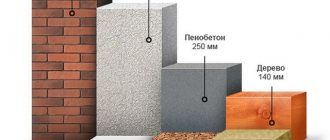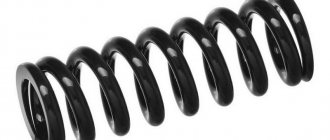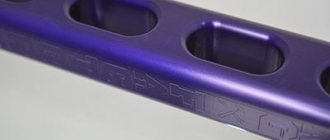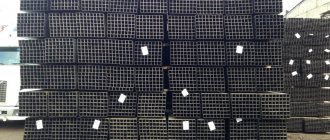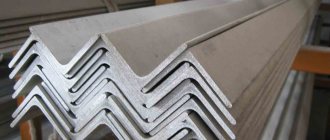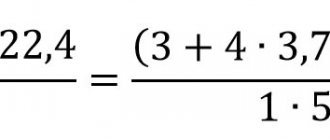Navigation through the TehTab.ru directory: main page / / Technical information
/
/ Physical reference book
/
/ Thermal quantities, including boiling, melting, flame, etc. ......
/
/ Heat capacity. Specific heat capacities. Adiabatic coefficient (indicator). // Indicative specific heat capacity of solid metals and alloys.
Indicative specific heat capacity of hard metals and alloys.Indicative specific heat capacity of hard metals and alloys.MetalSpecific heat capacity – cp(kJ/kg*K)=(kJ/kg*C)(BTU/lb*F)Admiralty brass - Admiralty Brass (30% zinc, and 1% tin) 0.380.09 Aluminum bronze, Aluminum Bronze 0.380.09 Aluminum tape (material for aluminum cans) - Ball metal 0.3600.086 Beryllium bronze (beryllium copper) - Beryllium Copper 0.420.10 Bronze - Bronze 0.4350.104 Yellow brass (lots of zinc ka) – Yellow Brass0.380.09 Inconel – Inconel0.460.11 Incaloy – Incoloy0.500.12 Stainless steel, nickel steel – Nickel steel0.4560.109 Red brass (low zinc) – Red Brass0.380.09 Brass – Brass0.3770.090 Manganese brass or manganese 1st bronze – Manganese Bronze0.380.09 Monel – Monel0.530.127 Solder 50% tin/ 50% lead – Solder 50/50 Sn Pb0.1670.04 Carbon steel – Steel0.460.11 Hastelloy – Hasteloy0.380.091 Cast Iron- Cast Iron0.500.12 Construction, thermal insulation and other materialsC, J/(kg · K) ABS plastic 1300…2300 Agloporite concrete and concrete based on fuel (boiler) slags 840 Diamond 502 Argillite 700… 1000 Fibrous asbestos 1050 Asbestos cement 1500 Asbestos textolite 1670 Asboshi slate 837 Asphalt 920… 2100 Asphalt concrete 1680 Aerogel ( Aspen aerogels)700Basalt850...920Barite461Birch1250Concrete710...1130Bitumenperlite1130Oil construction and roofing bitumens1680Paper1090...1500Mineral wool920Glass wool800Cotton wool1675Slag wool750Vermiculite840 Vermiculite concrete840Viniplast1000Wool felt1700Wax2930Gas and foam concrete, gas and foam silicate, gas - and foam ash concrete840 Getinaks1400 Dry molded gypsum1050 Drywall950 Clay750 Fireproof clay800 Alumina700...840 Gneiss (lining)880Gravel (filler)850 Expanded clay gravel840Shungizite gravel840Granite (lining)880...920G afit708 Wet soil (soil) 2010 Lunar soil 740 Sandy soil 900 Dry soil 850 Tar 1675 Diabase 800…900 Dinas 737 Dolomite 600… 1500 Oak 2300 Reinforced concrete 840 Rammed reinforced concrete 840 Wood ash 750 Limestone (cladding) 850… 920 Product made from expanded perlite on a bitumen binder 1680Il sand1000…2100 Construction stone920 Capron2300 Black carbolite1900 Corrugated cardboard1150 Facing cardboard2300 Thick cardboard1200 Multilayer building cardboard2390 Natural rubber1400 Crystalline quartz836 Quartzite700…1300 Expanded clay750 Expanded clay concrete and expanded clay top Enocrete840 Dinas brick905 Carborundum brick700 Red dense brick840…880 Magnesite brick1055 Facing brick880 Fireproof semi-acid brick885 Silicate brick750…840Building brick800Treble brick710 Fireclay brick930 “Poroton” masonry 900 Rubble masonry made of medium-density stones 880 Gas silicate masonry 880 Ordinary clay brick masonry 880 Ceramic hollow brick masonry 880 Masonry made of sand-lime brick880 Masonry made of slag brick880 Masonry made of slag brick880 Powdered coke 1210 Corundum 711 Oil paint (enamel) 650…2000 Silicon 714 Volcanic lava 840 Brass 400 Ice from heavy water 2220 Ice at a temperature of 0 ° C 2150 Ice at a temperature of -100 ° C 1170 L units at a temperature of -20°C1950Ice at a temperature of -60°C1700Linoleum1470Flat asbestos-cement sheets840Gypsum cladding sheets (dry plaster) 840 Sunflower husk 1500 Magnetite 586 Malachite 740 Stitched fiberglass mats and strips 840 Stitched mineral wool mats and with a synthetic binder 840 Chalk 800...880 Micanite 250 Mypora 1420 Marble (cladding) 880 Deck flooring 1100 Naphthalene 1300 Nylon 160 0 Neoprene 1700 Tow 2300 Paraffin 2890 Oak parquet 1100 Piece parquet 880 Panel parquet 880 Pumice concrete 840 Foam concrete 840 PVC-1 and PV-11 foam plastic 0Parchment 1680 Reinforced ceramic slab with concrete filling without plaster 850 Slab made of reinforced concrete elements with plaster 860 Monolithic slab flat reinforced concrete 840 Perlite concrete 840 Perlite plastic concrete 1050 Perlite phosphogel products 1050 Sand for construction work 840 Fine river sand 700…840 Fine river sand (wet) 2090 Sugar sand 1260 Dry sand 800 Fir 2700 Polyester plastic 1000… 2300 P cork casting 1850 Alabaster slabs 750 Wood fiber and particle boards (chipboard, fiberboard) 2300 Gypsum slabs 840 Resol-formaldehyde foam slabs 1680 Glass staple fiber slabs with a synthetic binder 840 slabs reed2300 Insulating flax slabs 2300 High-hardness mineral wool slabs 840 Semi-rigid mineral wool slabs with a starch binder 840 Heat-insulating peat slabs 2300 Fiberboard and wood concrete slabs on Portland cement 2300 Carpet covering 1100 Seamless gypsum flooring 800 Polyvinyl Loride (PVC) 920 Polycarbonate (Diflon) 1100…1120 Polymethyl methacrylate 1200… 1650 Polypropylene 1930 Polystyrene UPP1, PPS 900 Polystyrene concrete 1060 Polyvinyl chloride 1130… 1200 Polychlorotrifluoroethylene 920 High density polyethylene 1900… 2300 Low polyethylene density 1700 Portland cement 1130 Cork 2050 Granulated cork 1800 Gypsum trowel mortar 900 Gypsum perlite mortar 840 Porous gypsum perlite mortar 840 Mortar lime-sand 840 lime mortar 920 complex mortar (sand, lime, cement) 840 cement-perlite mortar 840 cement-sand mortar 840 cement-slag mortar 840 soft rubber 1380 porous rubber 2050 hard ordinary rubber 1350…1400 roofing felt 1500…168 0 Sulfur 715 Slate 700…1600 Mica 880 Epoxy resin 800… 1100 Stale snow at 0°C 2100 Freshly fallen snow 2090 Pine and spruce 2300 Resinous pine 15% humidity 2700 Mirror glass (mirror ) 780 Quartz glass 890 Laboratory glass 840 Ordinary glass, window glass 670 Flint glass 490 Glass wool 800 Fiberglass 840 Fiberglass 800 Pressed wood shavings 1080 Textolite 1470...1510 Tol 1680 Peat 1880 Peat slabs 2100 Tuff ovka)750…880 Tufobeton840 Charcoal960 Coal1310 Plywood2300…2500Porcelain750…1090Fibrolite (gray)1670Zircon670Chamotte825Slate750Granulated slag750Boiler slag700…750Slag concrete800Slag pumice tone (thermosite concrete) 840 Slag pumice foam and slag pumice gas concrete 840 Gypsum plaster 840 Plaster from polystyrene mortar 1200 Lime plaster 950 Lime plaster with stone dust 920 Perlite plaster 1130 Plaster façade with polymer additives880Shungizite concrete840Crushed stone and sand from expanded perlite840Crushed stone from blast furnace slag, slag pumice and agloporite840Ebonite1430Ecowool2300Etrol1500…1800
taken – thermalinfo.ru/eto-interesno/tablitsy-udelnoj-teploemkosti-veshhestv
Tables of specific heat capacity of substances are presented: gases, metals, liquids, construction and thermal insulation materials, as well as food products - more than 400 substances and materials.
The specific heat capacity of a substance is the ratio of the amount of heat imparted to a unit mass of this substance in any process to the corresponding change in its temperature.
The specific heat capacity of substances depends on their chemical composition, thermodynamic state and the method of imparting heat to them. In the International System of Units, this value is measured in J/(kg K).
It should be noted that the experimental determination of the specific heat capacity of liquids and gases is carried out at constant pressure or at constant volume. In the first case, the specific heat capacity is denoted by Cp, in the second by Cv. For liquids and gases, the most commonly used specific heat capacity at constant pressure is Cp.
For solids, the heat capacities Cp and Cv do not differ. In addition, in relation to solids, in addition to the specific mass heat capacity, specific atomic and molar heat capacities are also used.
Specific heat capacity of materials
Heat capacity is a physical quantity that describes the ability of a material to accumulate temperature from a heated environment. Quantitatively, specific heat capacity is equal to the amount of energy, measured in J, required to heat a body weighing 1 kg by 1 degree. Below is a table of the specific heat capacity of the most common materials in construction.
In order to calculate the heat capacity of a particular material, you must have the following data:
- type and volume of heated material (V);
- the specific heat capacity of this material (Sud);
- specific gravity (msp);
- initial and final temperatures of the material.
Advantages
Sand has a number of advantages, thanks to which the building can be used for many years. The main ones include:
- seismic resistance;
- tolerates sudden temperature changes, from severe frosts to hot climates;
- low compression of the material helps to place a heavy base on it, and at the same time additionally cushion the entire building. This is especially true in areas with frequent earthquakes;
- water permeability, which allows the purification of many liquids;
- wide range of applications in other areas.
It is not for nothing that GOST 8736 sand is used when installing filters. If the sand is sufficiently compacted, then water will not pass through it to great depths.
But before you start working with sand, it is worth familiarizing yourself with its other properties, for example, the filtration coefficient, compaction, bulk density, specific gravity and heat capacity of sand.
This important criterion is necessary when designing a future structure. There are many factors that affect heat capacity.
It is worth immediately emphasizing that heat capacity and thermal conductivity are two different qualities, having different designations and digital expressions. Below you can independently familiarize yourself with the table, which shows the parameters of both of these coefficients for sand.
Heat capacity of building materials
The heat capacity of materials, the table for which is given above, depends on the density and thermal conductivity of the material.
And the thermal conductivity coefficient, in turn, depends on the size and closedness of the pores. A fine-porous material, which has a closed pore system, has greater thermal insulation and, accordingly, lower thermal conductivity than a large-porous one.
This is very easy to see using the most common materials in construction as an example. The figure below shows how the thermal conductivity coefficient and the thickness of the material influence the thermal insulation qualities of external fences.
The figure shows that building materials with lower density have a lower thermal conductivity coefficient. However, this is not always the case. For example, there are fibrous types of thermal insulation for which the opposite pattern applies: the lower the density of the material, the higher the thermal conductivity coefficient will be.
Therefore, you cannot rely solely on the indicator of the relative density of the material, but it is worth taking into account its other characteristics.
Content
You already know that the amount of heat depends on the mass of the substance, the temperature difference and the type of substance. The quantity of heat ( $Q$ ) in SI is measured in joules ( $J$ ).
Let's take two bodies of the same mass and temperature, but from different substances. It is logical that different amounts of heat will be required to heat them by $1 \degree C$. In this case, we have different types of substances from which bodies are composed. Here we introduce a new concept - the specific heat capacity of a substance.
In this lesson we will look at this new definition for us, find out its physical meaning, and get acquainted with the specific heat capacity of various substances.
Comparative characteristics of the heat capacity of basic building materials
In order to compare the heat capacity of the most popular building materials, such as wood, brick and concrete, it is necessary to calculate the heat capacity for each of them.
First of all, you need to decide on the specific gravity of wood, brick and concrete. It is known that 1 m3 of wood weighs 500 kg, brick - 1700 kg, and concrete - 2300 kg. If we take a wall whose thickness is 35 cm, then through simple calculations we find that the specific gravity of 1 square meter of wood will be 175 kg, brick - 595 kg, and concrete - 805 kg. Next, we will select the temperature value at which thermal energy will accumulate in the walls. For example, this will happen on a hot summer day with an air temperature of 270C. For the selected conditions, we calculate the heat capacity of the selected materials:
- Wall made of wood: C=SudhmuddhΔT; Sder=2.3x175x27=10867.5 (kJ);
- Concrete wall: C=SudhmuddhΔT; Cbet = 0.84x805x27 = 18257.4 (kJ);
- Brick wall: C=SudhmuddhΔT; Skirp = 0.88x595x27 = 14137.2 (kJ).
From the calculations made, it is clear that with the same wall thickness, concrete has the highest heat capacity, and wood has the least. What does this mean? This suggests that on a hot summer day, the maximum amount of heat will accumulate in a house made of concrete, and the least amount of heat will accumulate in a house made of concrete.
This explains the fact that in a wooden house it is cool in hot weather and warm in cold weather. Brick and concrete easily accumulate a fairly large amount of heat from the environment, but just as easily part with it.
Using heat capacity in practice
Table of heat capacity of building materials.
Building materials with high heat capacity are used for the construction of heat-resistant structures. This is very important for private houses in which people live permanently. The fact is that such structures allow you to store (accumulate) heat, thanks to which the house maintains a comfortable temperature for quite a long time. First, the heating device heats the air and the walls, after which the walls themselves warm the air. This allows you to save money on heating and make your stay more comfortable. For a house in which people live periodically (for example, on weekends), the high thermal capacity of the building material will have the opposite effect: such a building will be quite difficult to heat quickly.
The heat capacity values of building materials are given in SNiP II-3-79. Below is a table of the main building materials and their specific heat capacity values.
Table 1
| Material | Density, kg/m3 | Specific heat capacity, kJ/(kg*°C) |
| Expanded polystyrene | 40 | 1,34 |
| Minvata | 125 | 0,84 |
| Gas and foam concrete | 650 | 0,84 |
| Gypsum sheets | 800 | 0,84 |
| Tree | 500 | 2,3 |
| Plywood | 600 | 2,3 |
| Ceramic brick | 1600 | 0,88 |
| Concrete | 2300 | 0,84 |
| Reinforced concrete | 2500 | 0,84 |
| Brickwork | 1800 | 0,88 |
Brick has a high heat capacity, so it is ideal for building houses and constructing stoves.
Speaking about heat capacity, it should be noted that heating stoves are recommended to be built from brick, since the value of its heat capacity is quite high. This allows you to use the stove as a kind of heat accumulator. Heat accumulators in heating systems (especially in water heating systems) are used more and more every year. Such devices are convenient because they only need to be heated well once with the intense fire of a solid fuel boiler, after which they will heat your home for a whole day or even more. This will significantly save your budget.
Return to contents
Heat capacity and thermal conductivity of materials
Thermal conductivity is a physical quantity of materials that describes the ability of temperature to penetrate from one wall surface to another.
To create comfortable indoor conditions, it is necessary that the walls have a high heat capacity and a low thermal conductivity coefficient. In this case, the walls of the house will be able to accumulate thermal energy from the environment, but at the same time prevent the penetration of thermal radiation into the room.
Table - expression of the main parameters of sand thermal conductivity
This table will help both novice builders and those who are not new to this business to quickly and accurately calculate the required amount of sand material for future construction.
Thermal conductivity table
If a construction type of sand of a standard GOST sample is used, then with a mass of 1600 kgm3 the thermal conductivity will be 0.35 W m*deg., and the heat capacity will be 840 Jkg*deg.
If wet river sand is used, then the parameters will be as follows: a mass of 1900 kgm3 has a thermal conductivity of 0.814 W m*deg, and a heat capacity of 2090 Jkg*deg.
All this data is taken from various manuals on physical quantities and thermal engineering tables, where many indicators are given specifically for building materials. So it will be useful to have such a book with you.
Use of various materials in construction
Tree
For comfortable living in a home, it is very important that the material has high heat capacity and low thermal conductivity.
In this regard, wood is the best option for houses not only for permanent but also for temporary residence. A wooden building that is not heated for a long time will respond well to changes in air temperature. Therefore, heating of such a building will occur quickly and efficiently.
Coniferous species are mainly used in construction: pine, spruce, cedar, fir. In terms of price-quality ratio, the best option is pine. Whatever you choose to design a wooden house, you need to consider the following rule: the thicker the walls, the better. However, here you also need to take into account your financial capabilities, since with an increase in the thickness of the timber, its cost will increase significantly.
Brick
This building material has always been a symbol of stability and strength. The brick has good strength and resistance to negative environmental influences. However, if we take into account the fact that brick walls are mainly constructed with a thickness of 51 and 64 cm, then in order to create good thermal insulation they additionally need to be covered with a layer of thermal insulation material. Brick houses are great for permanent residence. Once heated, such structures are capable of releasing the heat accumulated in them into space for a long time.
When choosing a material for building a house, you should take into account not only its thermal conductivity and heat capacity, but also how often people will live in such a house. The right choice will allow you to maintain coziness and comfort in your home throughout the year.
